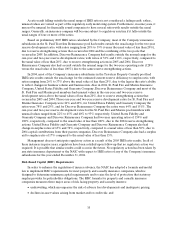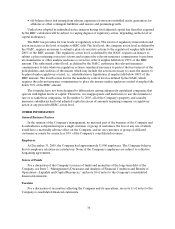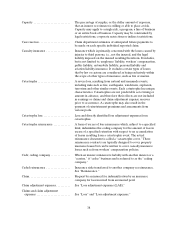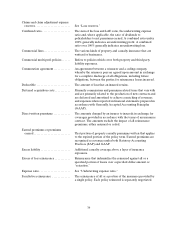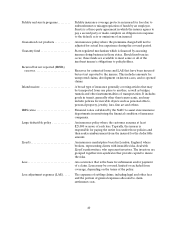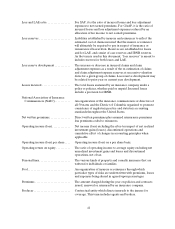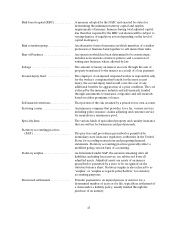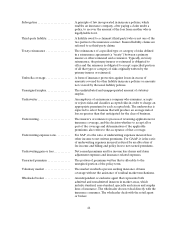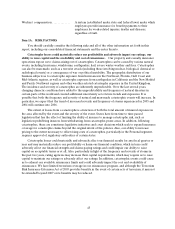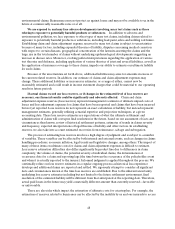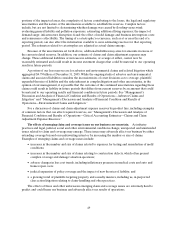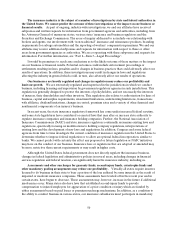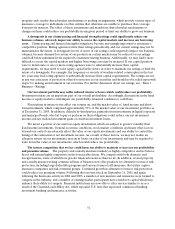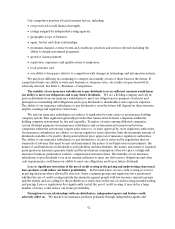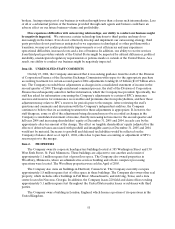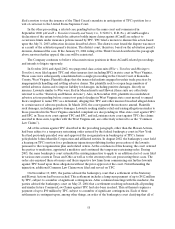Travelers 2005 Annual Report Download - page 57
Download and view the complete annual report
Please find page 57 of the 2005 Travelers annual report below. You can navigate through the pages in the report by either clicking on the pages listed below, or by using the keyword search tool below to find specific information within the annual report.45
Workers’ compensation............. A system (established under state and federal laws) under which
employers provide insurance for benefit payments to their
employees for work-related injuries, deaths and diseases,
regardless of fault.
Item 1A. RISK FACTORS
You should carefully consider the following risks and all of the other information set forth in this
report, including our consolidated financial statements and the notes thereto.
Catastrophe losses could materially reduce our profitability and adversely impact our ratings, our
ability to raise capital and the availability and cost of reinsurance.Our property and casualty insurance
operations expose us to claims arising out of catastrophes. Catastrophes can be caused by variousnatural
events, including hurricanes, windstorms, earthquakes, hail, severe winter weather and fires. Catastrophes
can also be man-made, such as a terrorist attack (including those involving nuclear, biological, chemical or
radiological events) or a consequence of war or political instability. The geographic distribution of our
business subjects us to catastrophe exposure from hurricanes in the Northeast, Florida, Gulf Coast and
Mid-Atlantic regions, as well as catastrophe exposure from earthquakes in California and the New Madrid
and Pacific Northwest regions and other weather-related catastrophe exposure in the United Kingdom.
The incidence and severity of catastrophes are inherently unpredictable. Over the last several years,
changing climactic conditions have added to the unpredictability and frequency of natural disasters in
certain parts of the world and created additional uncertainty as to future trends andexposures. It is
possible that both the frequency and severity of natural and man-made catastrophic events will increase. In
particular, we expect that the trend of increased severity and frequency of storms experienced in 2005 and
2004 will continue into 2006.
The extent of losses from a catastrophe is a function of both the total amount of insured exposure in
the area affected by the event and the severity of the event. States have from time to time passed
legislation that has the effect of limiting the ability of insurers to manage catastrophe risk, such as
legislation prohibiting insurers from withdrawing from catastrophe-prone areas. In addition, following
catastrophes, there are sometimes legislative initiatives and court decisions which seek to expand insurance
coverage for catastrophe claims beyond the original intent of the policies. Also, our ability to increase
pricing to the extent necessary to offset rising costs of catastrophes, particularly in the Personal segment,
requires approval of regulatory authorities of certain states.
Catastrophe losses could materially and adversely affect our financial results for any fiscal quarter or
year and may materially reduce our profitability or harm our financial condition, which in turncould
adversely affect our financial strength and claims-paying ratings and could impair our ability to raise
capital on acceptable terms or at all. Also, particularly in light of the frequency and severity of storms in
the past two years, rating agencies may increase their capital requirements, which may require us to raise
capital to maintain our ratings or adversely affect our ratings. In addition, catastrophic events could cause
us to exhaust our available reinsurance limits and could adversely impact the cost and availability of
reinsurance. We have limited terrorism coverage in our reinsurance program, and although the Terrorism
Risk Insurance Extension Act of 2005 provides benefits in the event of certain acts of terrorism, it may not
be extended beyond 2007 or its benefits may be reduced.


